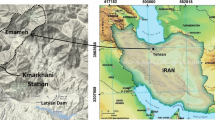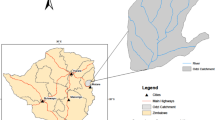Abstract
Reliable estimation of the mass-flux profiles of aeolian sediment is essential for predicting sediment transport rates accurately and designing measures to cope with wind-erosion. Vertical mass-flux profiles from seventeen wind-erosion events were re-evaluated using five typical models based on observed data obtained from a smooth bare field at the southern fringe of the Taklimakan Desert, China. The results showed that the exponential- function model and the logarithmic-function model exhibited the poorest fit between observed and predicted mass-flux profiles. The power-function model and the modified power-function model improved the fit to field data to an equivalent extent, while the five-parameter combined-function model with a scale constant (σ) of 0.00001 m (different from the σ value proposed by Fryear, which represented the height above which 50% of the total mass flux occurred) was verified as the best for describing the vertical aeolian sediment mass-flux profiles using goodness of fit (R 2) and the Akaike Information Criterion (AIC) values to evaluate model performance. According to relationships among model parameters, the modified power model played a prominent explanatory role in describing the vertical profiles of the observed data, whereas the exponential model played a coordinating role. In addition, it was found that the vertical profiles could not be extrapolated using the five selected models or easily estimated using an efficient model without field observations by a near-surface sampler at 0 to 0.05 m.
Similar content being viewed by others
References
Akaike H. 1974. A new look at the statistical model identification. IEEE Transactions on Automatic Control, 19(6): 716–723.
Anderson R S, Hallet B. 1986. Sediment transport by wind: Toward a general model. Geological Society of America Bulletin, 97(5): 523–535.
Anderson R S, Haff P K. 1988. Simulation of eolian saltation. Science, 241(4857): 820–823.
Anderson R S, Sørensen M, Willetts B B. 1991. A review of recent progress in our understanding of Aeolian sediment transport. In: Barndorff-Nielsen O E, Willetts B B. Aeolian Grain Transport: Mechanics. Acta Mechanica Supplementum. Vienna: Springer, 1: 1–19.
Bagnold R A. 1937. The transport of sand by wind. The Geographical Journal, 89(5): 409–438.
Bagnold R A. 1941. The Physics of Blown Sand and Desert Dunes. New York: William Morrow & Company, 12–36.
Butterfield G R. 1999. Near-bed mass flux profiles in Aeolian sand transport: high-resolution measurements in a wind tunnel. Earth Surface Processes and Landforms, 24(5): 393–412.
Chen W N, Yang Z T, Zhang J S, et al. 1996. Vertical distribution of wind-blown sand flux in the surface layer, Taklamakan Desert, Central Asia. Physical Geography, 17(3): 193–218.
Chepil W S. 1945. Dynamics of wind erosion: I. Nature of movement of soil by wind. Soil Science, 60(4): 305–320.
Dong Z B, Liu X P, Wang H T, et al. 2003. The flux profile of a blowing sand cloud: a wind tunnel investigation. Geomorphology, 49(3–4): 219–230.
Dong Z B, Qian G Q. 2007. Characterizing the height profile of the flux of wind-eroded sediment. Environmental Geology, 51(5): 835–845.
Dong Z B, Lu J F, Man D Q, et al. 2011. Equations for the near-surface mass flux density profile of wind-blown sediments. Earth Surface Processes and Landforms, 36(10): 1292–1299.
Du H Q, Xue X, Wang T. 2014. Estimation of the quantity of aeolian saltation sediments blown into the Yellow River from the Ulanbuh Desert, China. Journal of Arid Land, 6(2): 205–218.
Fryrear D W. 1987. Aerosol measurements from 31 dust storms. In: Ariman T, Veziroglu T N. Particulate and Multiphase Flows: Contamination Analysis and Control. New York: Hemisphere, 407–415.
Fryrear D W, Stout J E, Hagen L J, et al. 1991. Wind erosion: field measurement and analysis. Transactions of the American Society of Agricultural and Biological Engineers, 34(1): 155–160.
Fryrear D W, Saleh A. 1993. Field wind erosion: vertical distribution. Soil Science, 155(4): 294–300.
Gillette D A, Fryrear D W, Xiao J B, et al. 1997. Large-scale variability of wind erosion mass flux rates at Owens Lake, 1. Vertical profiles of horizontal mass fluxes of wind-eroded particles with diameter greater than 50 µm. Journal of Geophysical Research, 102(22): 25977–25987.
Greeley R, Blumberg D G, Williams S H. 1996. Field measurements of the flux and speed of wind-blown sand. Sedimentology, 43(1): 41–52.
Griffin D W, Kellogg C A, Shinn E A. 2001. Dust in the wind: Long range transport of dust in the atmosphere and its implications for global public and ecosystem health. Global Change and Human Health, 2(1): 20–33.
Ikazaki K, Shinjo H, Tanaka U, et al. 2011. Field-scale Aeolian sediment transport in the Sahel, West Africa. Soil Science Society of America Journal, 75(5): 1885–1897.
Kok J F, Renno N O. 2009. A comprehensive numerical model of steady state saltation (COMSALT). Journal of Geophysical Research, 114(D17), doi: 10.1029/2009JD011702.
Lal R. 1990. Soil Erosion in the Tropics: Principles and Management. New York: McGraw-Hill.
Lal R. 2001. Soil degradation by erosion. Land Degradation & Development, 12(6): 519–539.
Leys J F, Mc Tainsh G H. 1996. Sediment fluxes and particle grain-size characteristics of wind-eroded sediments in southeastern Australia. Earth Surface Processes and Landforms, 21(7): 661–671.
McEwan I K, Willetts B B. 1991. Numerical model of the saltation cloud. In: Barndorff-Nielsen O E, Willetts B B. Aeolian Grain Transport: Mechanics. Acta Mechanica Supplementum. Vienna: Springer, 1: 53–66.
Mertia R S, Santra P, Kandpal B K, et al. 2010. Mass-height profile and total mass transport of wind eroded Aeolian sediments from rangelands of the Indian Thar Desert. Aeolian Research, 2(2–3): 135–142.
Nalpanis P. 1985. Saltating and suspended particles over flat and sloping surfaces: II. Experiments and numerical simulations. In: Barndorff-Nielsen O E, Møller J T, Rasmussen K R, et al. Proceedings of International Workshop on the Physics of Blown Sand. Denmark: Aarhus University, 37–66.
Namikas S L. 2003. Field measurement and numerical modelling of aeolian mass flux distributions on a sandy beach. Sedimentology, 50(2): 303–326.
Ni J R, Li Z S, Mendoza C. 2002. Vertical profiles of Aeolian sand mass flux. Geomorphology, 49(3–4): 205–218.
Owen P R. 1964. The saltation of uniform sand in air. Journal of Fluid Mechanics, 20(2): 225–242.
Panebianco J E, Buschiazzo D E, Zobeck T M. 2010. Comparison of different mass transport calculation methods for wind erosion quantification purposes. Earth Surface Processes and Landforms, 35(13): 1548–1555.
Pettke T, Halliday A N, Hall C M, et al. 2000. Dust production and deposition in Asia and the north Pacific Ocean over the past 12 Myr. Earth and Planetary Science Letters, 178(3–4): 397–413.
Shao Y, Mctainsh G H, Leys J F, et al. 1993. Efficiencies of sediment samplers for wind erosion measurement. Australian Journal of Soil Research, 31(4): 519–532.
Shao Y P, Raupach M R. 1992. The overshoot and equilibration of saltation. Journal of Geophysical Research, 97(D18): 20559–20564.
Shao Y P. 2009. Physics and Modelling of Wind Erosion (2nd ed.). Boston: Kluwer Academic Publishers.
Shi F, Huang N. 2010. Computational simulations of blown sand fluxes over the surfaces of complex microtopography. Environmental Modelling and Software, 25(3): 362–367.
Sørensen M. 1991. An analytic model of wind-blown sand transport. In: Barndorff-Nielsen O E, Willetts B B. Aeolian Grain Transport: Mechanics. Acta Mechanica Supplementum. Vienna: Springer, 1: 67–82.
Sterk G, Raats P A C. 1996. Comparison of models describing the vertical distribution of wind-eroded sediment. Soil Science Society of America Journal, 60(6): 1914–1919.
Stout J E, Zobeck T M. 1996. The Wolfforth field experiment: a wind erosion study. Soil Science, 161(9): 616–632.
Takeuchi M. 1980. Vertical profile and horizontal increase of drift-snow transport. Journal of Glaciology, 26(94): 481–498.
Ungar J E, Haff P K. 1987. Steady state saltation in air. Sedimentology, 34(2): 289–299.
Vories E D, Fryrear D W. 1991. Vertical distribution of wind-eroded soil over a smooth, bare field. Transactions of the Asae, 34:1763–1768.
Werner B T. 1990. A steady-state model of wind-blown sand transport. The Journal of Geology, 98(1): 1–17.
White B R. 1982. Two-phase measurements of saltating turbulent boundary layer flow. International Journal of Multiphase Flow, 8(5): 459–473.
Williams G. 1964. Some aspects of the Aeolian saltation load. Sedimentology, 3(4): 257–287.
Yang X H, He Q, Mamtimin A, et al. 2012. A field experiment on dust emission by wind erosion in the Taklimakan Desert. Acta Meteorologica Sinica, 26(2): 241–249.
Zheng X J, He L H, Wu J J. 2004. Vertical profiles of mass flux for windblown sand movement at steady state. Journal of Geophysical Research, 109(B1), doi: 10.1029/2003JB002656.
Zheng X J. 2009. Mechanics of Wind-blown Sand Movements. Berlin: Springer.
Zingg A W. 1953. Wind tunnel studies of the movement of sedimentary material. In: Proceedings of the 5th Hydraulics Conference. Bulletin. Iowa City: Institute of Hydraulics, 111–135.
Zobeck T M, Sterk G, Funk R, et al. 2003. Measurement and data analysis methods for field-scale wind erosion studies and model validation. Earth Surface Processes and Landforms, 28(11): 1163–1188.
Author information
Authors and Affiliations
Corresponding author
Rights and permissions
About this article
Cite this article
Xue, J., Lei, J., Li, S. et al. Re-evaluating the vertical mass-flux profiles of aeolian sediment at the southern fringe of the Taklimakan Desert, China. J. Arid Land 7, 765–777 (2015). https://doi.org/10.1007/s40333-015-0134-9
Received:
Revised:
Accepted:
Published:
Issue Date:
DOI: https://doi.org/10.1007/s40333-015-0134-9




